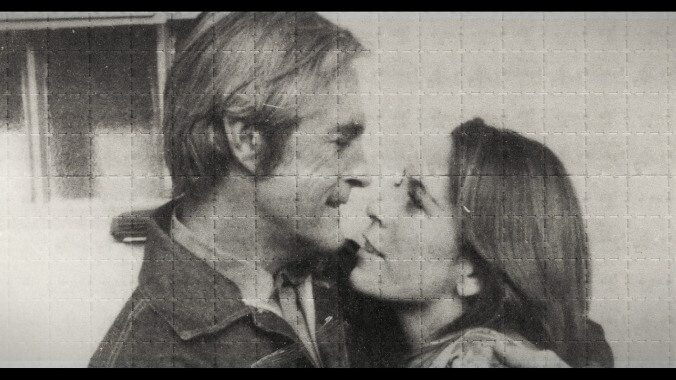My Psychedelic Love Story is a slight tribute to Timothy Leary’s “Acid Queen”

Errol Morris’ 2017 miniseries Wormwood chronicles the controversial events surrounding the death of Frank Olson, a biological warfare scientist who plummeted to his death from a New York City hotel window nine days after being unknowingly dosed with LSD by the CIA. Though the government eventually admitted that Olson’s death was likely a suicide brought on by being subject to drug experiments from the CIA’s MKULTRA program, Olson’s son, Eric, firmly believes he was murdered because of his knowledge of covert germ warfare in Korea. Morris’ interviews with Eric Olson shed light on the days leading up to his father’s death and the long sketchy aftermath, but Wormwood poses more questions than answers, because it’s primarily about the insidiousness of uncertainty. The United States wasn’t just responsible for Frank Olson’s death, but for poisoning his kin with permanent doubt.
When Joanna Harcourt-Smith saw Wormwood, it reignited similar suspicions about her own role in another case of governmental persecution, albeit one that was more public and ideologically fraught. A flower power socialite, Harcourt-Smith gallivanted around the world in search of adventure during the ’60s, hanging out with celebrities like the Rolling Stones. Her life changed dramatically when she fell in love with psychologist and philosopher Timothy Leary while he was a fugitive in Europe on drug-related charges. She and Leary dropped acid and traveled together until Leary was arrested in Afghanistan and extradited back to the United States for a 95-year prison term. When Leary eventually cut a deal with the FBI to shorten his sentence, not only did prominent countercultural figures turn their backs on him, they also concluded that Harcourt-Smith was a possible CIA plant who led to his capture. Unsure if she actually was a government pawn, she eventually sought out Morris to try to help her figure it out. Morris’ latest documentary My Psychedelic Love Story, inspired by Harcourt-Smith’s memoir of the same name, lightly explores the possibility that she was used as a Mata Hari to ensnare the High Priest Of Acid, but the film doesn’t wear itself down by trying to uncover the literal truth.
Morris lets Harcourt-Smith recount her life story, from her unhappy childhood in Switzerland to her time spent with Leary to when she was actively targeted by the Nixon administration. Through her recollection, certain memories strongly emerge while others remain faint, and the narrative necessarily becomes rife with subjective exaggerations and incidental falsehoods. While My Psychedelic Love Story works as a thematic companion piece to Wormwood, it’s more of a focused tribute to Harcourt-Smith’s vibrant life as a ’60s adventurer and psychedelic advocate, a particularly potent choice considering she died from cancer in October of this year.
While Harcourt-Smith’s story frequently compels on its own merits, Morris supplements his subject’s tale by imbuing My Psychedelic Love Story with a hallucinogenic visual framework. Archival stills woozily undulate while film footage is presented with colorful filters. Enormous superimposed text splatters onto the screen so that certain phrases “pop.” Harcourt-Smith’s voiceover as well as recordings of Leary are rendered with analog scratches and tape noise. With the help of Jeremy Landman’s graphics work and Igor Martinovic’s warm-toned photography, Morris broadly simulates the feeling of an acid trip without losing focus on Harcourt-Smith. Some of these formal elements certainly flirt with stereotypical “trippy” clichés, especially the Alice In Wonderland motifs, but Morris’ efforts to visually enhance a discursive, sprawling narrative are appreciated.
Yet, neither Morris’ aesthetic choices nor fun stories of international intrigue can save My Psychedelic Love Story from feeling fairly slight. Harcourt-Smith’s gentle charisma simply can’t sustain My Psychedelic Love Story for its entire 100 minutes, and the film eventually drags both because of the material itself and her fractured recollection of it. The core story of Leary’s capture in Afghanistan only comprises a portion of My Psychedelic Love Story, thus Morris’ film mostly features Harcourt-Smith processing her involvement and potential liability. We watch her make multiple connections between different events in order to illuminate her behavior, like linking a disturbing assault at the hands of her mother’s chauffeur to her fascination with LSD as a means of trauma therapy, yet these clarifying moments are naturally few and far between. Plus, while Leary’s shadow hangs over the film through the sheer volume of archival footage, he has a relatively compromised role, in part because his relationship with Harcourt-Smith was brief and mostly physically displaced. He’s both present and absent at the same time, a figure whose mythos comes through sharper than his actual self, which ultimately renders his prominence in My Psychedelic Love Story slightly confused.
It’s admirable that Morris provides Harcourt-Smith with the space to try to assemble the disparate pieces of her life, but it’s unfair to expect this voyage of self-discovery to uphold the entire film. Though Morris occasionally asserts his voice to raise disbelief or ask a clarifying question, the burden largely falls on Harcourt-Smith to keep the film constantly engaging, and it’s ultimately too much to bear. My Psychedelic Love Story is a sweet paean to a lovely woman whose experiences during a moment of massive cultural upheaval are worth preserving, but it’s not much more than that.